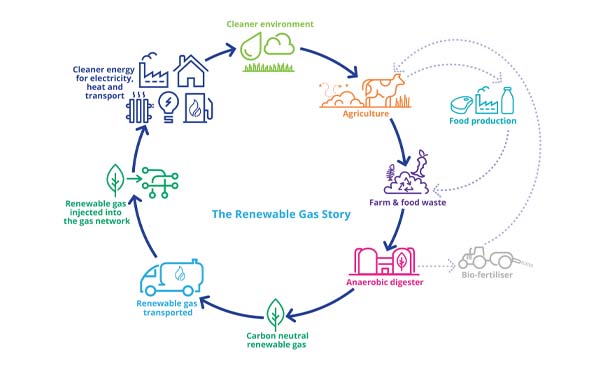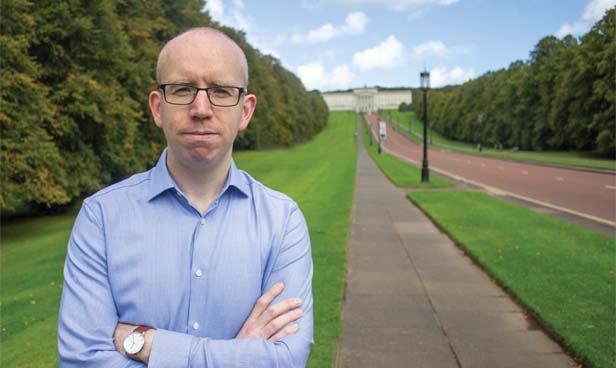
Digitalisation of the energy sector: The future is smart!
5th October 2021
The gas network: Ireland’s renewables-ready decarbonisation solution
5th October 2021Delivering an Energy Strategy

Ahead of the publication of Northern Ireland’s Energy Strategy later in 2021, David Whelan speaks to the Department for the Economy’s (DfE) Director for Energy Strategy, Thomas Byrne.
In July 2021, the window for response to the policy options consultation paper for the new Energy Strategy closed, bringing Northern Ireland one step closer to a new vision for energy in the wider context of global decarbonisation.
The Strategy and, potentially more critically, its associated action plan, have been scheduled for publication before the end of the year, with the Department currently working through the range of responses it received during the consultation.
Byrne, who has led the development of the Strategy and various stakeholder and consumer outreach initiatives in recent years, is pleased with the levels of engagement, highlighting the almost 8,000 views recorded on the consultation page, as well as nearly 4,000 downloads of the document and 282 responses, over a three-month period.
Tellingly, given the emphasis that Byrne and his team have placed on ensuring the consultation captured as broad a base as possible, around 50 per cent of responses came directly from domestic and business consumers.
With the Department now working through those responses to inform the Strategy and its relevant policies, Byrne is confident that its delivery and that of the associated action plan remains on track, despite the impact of the pandemic.
In fact, the Director believes that the past two years of the pandemic has placed a greater onus on the importance of the Strategy, as well as increasing interest in it.
“The Strategy has always been an important piece of policy, but I believe its reach across society is broader now than ever before,” he says. “Firstly, because the awareness of the impact of climate change and the need to take action is higher. The Strategy covers around two-thirds of emissions here in Northern Ireland and I think that puts a lot of strategic focus on what we are doing.
“Secondly, the impact of the pandemic means that we are trying to rebuild an economy that can be sustainable for the long-term. One of our guiding principles is for the growth of a green economy, the success of which will be founded on our net-zero ambitions.”
Byrne points out that ambitions for green growth features in a breadth of fresh government policies, ranging from the draft Programme for Government outcomes through to DfE’s 10X economic vision and Economic Recovery Action Plan; areas where energy policy may not have traditionally featured but is now playing a central role.
Action plan
Outlining what is set to be unveiled, Byrne describes the Strategy as a “high-level strategic look at the direction of travel, focused on the period up to 2030, as part of the longer journey to 2050”. However, he is also aware of stakeholder demand for delivery and to this end, he points to the action plan, which he describes as establishing the “short-term immediate measures which we want to take”.
The Energy Strategy Director emphasises the likelihood of an annual review process to be built into the action plan, which in turn will enable the Strategy to be updated as new evidence becomes available.
“Something we have heard loud and clear from stakeholders is that while they are pleased with the work we are doing on the Strategy, our energy transition is also about delivery, and they want to have confidence in what we are planning to do. That is the reason behind our development of a high-level strategic vision, complimented by a more detailed action plan.”
Energy target
Interestingly, Northern Ireland’s Energy Strategy is likely to emerge before the region’s climate targets are established in law. Northern Ireland, as the only region of the UK without its own climate legislation, is in the unique position of having two separate climate bills progressing through the Assembly.
Byrne is quick to point out that the outcome of climate legislation is unlikely to impact the net-zero ambitions being pursued in relation to energy, although the timescales to achieving this goal may differ.
“Our direction is net-zero carbon for energy, which is in line with the CCC advice and indeed, both bills coming forward in the Assembly.”
The policy options paper identified five principles for the new Energy Strategy. These are:
- placing you at the heart of our energy future;
- growing a green economy;
- doing more with less;
- replacing fossil fuels with indigenous renewables; and
- creating a flexible and integrated energy system.
Byrne confirms the assumption that a consumer-centred approach was intentionally marked as the first principle, highlighting that while the Energy Strategy can be a major enabler of Northern Ireland’s energy transition, consumers will essentially dictate the scale of the transition.
“We cannot reach our vision of reaching net zero carbon and affordable energy without consumers and people at the heart,” he states. “Only part of this transition will be about technology, and it is ultimately going to be decisions by people and consumers that define success, whether that is around investing in buildings, or the energy they use for heating systems or transport.
“That is why a big part of our work is around ensuring that they have both the knowledge and buy-in to signal the decisions that will be needed in the future.”
Pre-strategy
The Director emphasises a point made in the policy options paper that the Department will not wait for the publication of the new Strategy to progress urgent issues. The Department’s recently announced Economic Recovery Action Plan included £20 million of green recovery intervention.
Byrne says that he and his team have been keen to offer clear signals to the renewables industry around their intentions, highlighting the need to kickstart projects and investments, where possible, ahead of the Strategy’s publication.
He points to former Economy Minister Diane Dodds MLA’s announcement in 2020 that any new target in the Energy Strategy would not be below 70 per cent renewable electricity by 2030, as a good example of how the Department has sought to offer direction to industry prior to the Strategy’s consultation.
“Support is an important part of the conversation, but it is only one facet. Behavioural change and changes to regulations and standards will be vital to driving as well. Ultimately, it is about finding the cleverest and most cost-effective way of meeting our objectives.”
Similarly, and more recently, Byrne says that the £5 million allocation of funding to NI Water to trial electrolyser technology for the production of hydrogen and oxygen, alongside key statements on the opportunities presented by the development of a hydrogen economy for Northern Ireland, has been welcomed.
Asked what he identifies as the areas of maximum opportunity when the Strategy is published, Byrne is quick to point out that some technologies being discussed today are still between 10 and 15 years away from being scalable. To this end, he points to two areas he believes can have a massive impact in the short term: energy efficiency and renewable electricity.
“Energy efficiency has to be at the heart the Energy Strategy. It is not just about decarbonising energy; it is also about reducing the amount we use. That is why one of our principles is about doing more with less. We want to have a really strong strategic focus on driving energy efficiency. It is a no-brainer and something we must do no matter what the technologies are.”
On renewable electricity, he adds: “We have already had significant success in meeting our renewable electricity targets. We have excellent wind resources and the technologies in this area are generally well-established and proven and so, giving that signal to industry and putting in place the mechanisms we need to bring forward investment in these two areas is something we will look to do at the earliest opportunity.”
Byrne says that an early focus on these two areas will allow for Northern Ireland to position itself well for technologies of the future, but also ensure that the region is not reliant on them.
“When we do publish the Strategy later this year, you will see that focus on low and ‘no regret’ technologies which we know will work, alongside a continuation to move forward on those more uncertain technologies of the future.”
Affordability
Key to any strategic vision for what technologies will take Northern Ireland to net-zero carbon is affordability for consumers. Byrne says that inclusion of affordability upfront in the Strategy’s vision is key, highlighting that the transition is not only about enabling consumer participation in energy but also about consumer protection, particularly those viewed as the most vulnerable.
“The CCC’s long-term view is that investment in renewable technologies will lead to a system that is cheaper in the long term. However, that is going to take time to get to that point and one of the key strategic questions, not just for Northern Ireland but for every government trying to reach decarbonisation targets, is where do we target that investment? What are the most cost-effective routes? And ultimately, who pays?”
To this end, Byrne points to a focus on energy efficiency as something that will have a tangible impact on reducing consumer bills. Additionally, he believes that economic benefits will be made through a strategic focus on Northern Ireland’s indigenous energy sources, and a move away from importing fossil fuels.
“It is not that indigenous renewables are necessarily cheaper than fossil fuels but our reliance on importing fossil fuels means that consumers remain at the mercy of international markets. Taking control through use of our own natural resources and investing in technologies to support that will mean that any investment we make will be retained within the Northern Ireland economy.”
Flexibility
Although the Department is set to deliver a strategic vision, Byrne is keen to acknowledge the levels of flexibility built into the strategy. The Director says that the “living, breathing document” will undoubtedly need revisited and updated, most likely on an annual basis.
Supports
A key question being asked by stakeholders concerns the form of supports coming forward to facilitate behavioural change. Byrne stresses that the initial strategy is about establishing what Northern Ireland hopes to achieve and what technologies it can progress, which can then be followed by supports as mechanisms to deliver on that vision. However, he points to green innovation, bringing forward low-carbon technologies to be developed in Northern Ireland to support a green economy, as one area of focus. Additionally, he says that the expansion of the Contracts for Difference (CfD) scheme, being utilised in Great Britain, is under consideration for supporting renewable electricity in Northern Ireland. Finally, he points ongoing consideration of how consumers can be best supported to invest in their own buildings and, in particular, tailoring that support to who needs it most.
However, Byrne concedes that as we look to less-established technologies, such as heat pumps and decarbonised gas, there is still work to be done around cost and what supports will be needed to encourage consumer and industry investment.
“Support is an important part of the conversation, but it is only one facet. Behavioural change and changes to regulations and standards will be vital to driving as well. Ultimately, it is about finding the cleverest and most cost-effective way of meeting our objectives.
“We have developed the consultation on the basis of all departments working together to produce the Strategy, with it coming forward as an Executive document. That gives it the wide political cover and support in terms of what we want to do.”
“We want to use the Strategy as the starting point of a range of consultations and engagements so we meet those objectives and I imagine supports will be a part of most of those conversations,” says Byrne.
The Director acknowledges that the regulatory regime in Northern Ireland must be right for new technologies to emerge. He is pleased that the Utility Regulator and the Consumer Council have been closely involved in the development of the Strategy, ensuring that consumers’ interests are at its heart.
Cost
Concluding on whether he feels that the Strategy will be allocated the necessary funding to fulfil its ambition in an economic climate of pressurised departmental budgets, Byrne points to an intention for the Strategy to be an Executive document, rather than owned solely by one department.
“The fact is that energy policy is spread across multiple departments,” he states, adding: “We have developed the consultation on the basis of all the departments working together to produce the Strategy, with it coming forward as an Executive document. That gives it the wide political cover and support in terms of what we want to do.
“However, while there is an obvious role for government, it is also worth noting that the private sector will have a big role in this as well. We need to continue the conversations around how we best stimulate the private sector to make these investments.”
Byrne does not have a firmer target date than the suggested publication of the Strategy before the end of the year, however, he does state that the Department will look at any opportunities to publish the strategy sooner. COP26, set to be held in Glasgow in early November 2021, represents an opportunity for Northern Ireland to announce its vision for energy.
